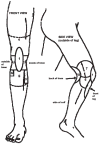The diagnostic performance of anterior knee pain and activity-related pain in identifying knees with structural damage in the patellofemoral joint: the Multicenter Osteoarthritis Study
- PMID: 24931959
- PMCID: PMC4182011
- DOI: 10.3899/jrheum.131555
The diagnostic performance of anterior knee pain and activity-related pain in identifying knees with structural damage in the patellofemoral joint: the Multicenter Osteoarthritis Study
Abstract
Objective: To determine the diagnostic test performance of location of pain and activity-related pain in identifying knees with patellofemoral joint (PFJ) structural damage.
Methods: The Multicenter Osteoarthritis Study is a US National Institutes of Health-funded cohort study of older adults with or at risk of knee osteoarthritis. Subjects identified painful areas around the knee on a knee pain map and the Western Ontario and McMaster Universities Osteoarthritis Index was used to assess pain with stairs and walking on level ground. Cartilage damage and bone marrow lesions were assessed from knee magnetic resonance imaging. We determined the sensitivity, specificity, positive and negative predictive values for presence of anterior knee pain (AKP), pain with stairs, absence of pain while walking on level ground, and combinations of tests in discriminating knees with isolated PFJ structural damage from those with isolated tibiofemoral joint (TFJ) or no structural damage. Knees with mixed PFJ/TFJ damage were removed from our analyses because of the inability to determine which compartment was causing pain.
Results: There were 407 knees that met our inclusion criteria. "Any" AKP had a sensitivity of 60% and specificity of 53%; and if AKP was the only area of pain, the sensitivity dropped to 27% but specificity rose to 81%. Absence of moderate pain with walking on level ground had the greatest sensitivity (93%) but poor specificity (13%). The combination of "isolated" AKP and moderate pain with stairs had poor sensitivity (9%) but the greatest specificity (97%) of strategies tested.
Conclusion: Commonly used questions purported to identify knees with PFJ structural damage do not identify this condition with great accuracy.
Keywords: MAGNETIC RESONANCE IMAGING; OSTEOARTHRITIS; PAIN.
Figures
References
-
- Duncan RC, Hay EM, Saklatvala J, Croft PR. Prevalence of radiographic osteoarthritis—it all depends on your point of view. Rheumatology. 2006;45:757–60. - PubMed
-
- Duncan R, Peat G, Thomas E, Wood L, Hay E, Croft P. How do pain and function vary with compartmental distribution and severity of radiographic knee osteoarthritis? Rheumatology. 2008;47:1704–7. - PubMed
-
- Hunter DJ, March L, Sambrook PN. The association of cartilage volume with knee pain. Osteoarthritis Cartilage. 2003;11:725–9. - PubMed
Publication types
MeSH terms
Grants and funding
LinkOut - more resources
Full Text Sources
Other Literature Sources
Medical
Miscellaneous

